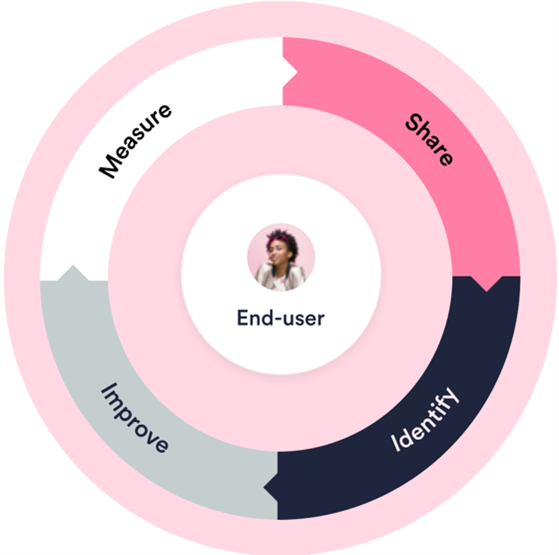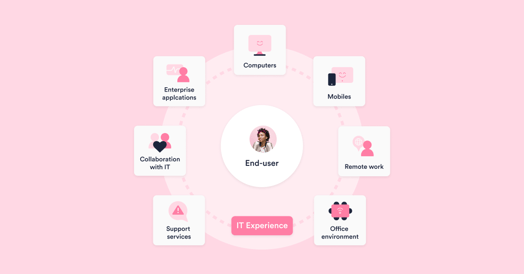The term experience is everywhere we turn. Sometimes its frequent, buzz-word usage borders on the comical: I remember when one helicopter tour company described itself as providing a “better vertical lift experience.” Sometimes, the current language about experience indicates that it’s something separate from the person; it isn’t. As much as we’d like to think that we can design an experience, we will miss the mark, at least sometimes, because people experience things individually and differently.
Many managers and executives are still wary of basing decisions on experience. They are skeptical of using subjective criteria like expectations and perceptions when considering changes, improvements, and especially expenditures. If we stop to think about why an organization would make a particular change or purchase a specific product or service, however, the value of experience becomes apparent.
Inside-out versus human-centric thinking
“Human-centric IT is about putting your end-users at the heart of your IT touchpoints and listening to how they’re experiencing IT services.”
IT was a victim of its own “inside-out” thinking for decades. Some cool new tool became available, and techies wanted to buy it, install it, and use it, whether or not it produced the outcomes the organization needed and whether the people using it liked it. This approach began to shift when the trend called consumerization took hold. Corporate IT tended to be slow and clumsy; waiting for IT-related change required much patience. End-users wanted the same ease and comfort as with the technology they experienced daily outside of work.
There were better ways to do things, and employees knew it. They wanted better ways to share information, collaborate, and get work done, and they found those better ways in services and tools that the organization did not provide. They found ways around corporate IT restrictions and gave birth to “Shadow IT,” often using inexpensive cloud-based tools and services not sanctioned, provided, or supported by the organization.
It took time, but IT began to respond and looked for better ways to determine its own path. It became apparent to forward-thinkers that the concept of experience could illuminate that path. Opening up dialogs with end-users and providing better, faster feedback loops was essential, and IT end-user experience management (ITXM™) began to gain a foothold.
How end-user happiness leads to improvement
By publishing multiple customer case studies and the semi-annual Global IT Experience Benchmark Report, Happy Signals is showing the world how ITXM makes a difference to businesses worldwide by:
All of the advantages provided by ITXM™ depend on the simple premise that IT is human-centric; in other words, people are the reason for IT. People are having a great or bad day because of their ability or inability to get work done using the technology and services IT provides or recommends. If we can get rapid and specific feedback on their perceptions and feelings—both positive and negative—about the technology and services, we can make considered improvements that matter.
Keep the human side in
In many areas of experience management, however, we risk losing sight of our original intention. We’ve become convinced that we can predict how people will experience things, so we begin to mistake our predictions for experiences themselves. Our desire for positive feedback can overshadow our desire to improve our work.
As mentioned earlier, IT was a victim of its own “inside-out” thinking. Bringing the end-user experience into focus was intended as an antidote, moving IT to an “outside-in” way of doing things, more in line with the famous statement by Steve Jobs: “You have to start with the customer experience and work backward to the technology.” If, however, we begin to believe we can control the experience, we are straying back into “inside-out” thinking.
A good safeguard against this is using the ITXM™ Framework.

- The first step in the Framework is to measure how end-users think and feel about the technology and services they are offered. Not to design or control but simply to measure.
- The next step is to share the measurement findings honestly and openly with stakeholders across the organization. This step means taking the experience data seriously and ensuring we are not just publishing results that make us look good.
- With the experience data in hand, we can identify areas for improvement. What’s holding end-users up? What’s causing lost time? What’s making people unhappy?
- Once we know what people are experiencing, we can improve those areas.
Focus on the experience, not the measure
When we measure, we mustn’t impose a target or goal on the measurement itself. Goodhart’s Law tells us that measurements cease to be valid if they—in themselves—become targets. We need to remain focused on improving the experience, not on raising the number that results from our measurement of the experience.
Keeping our focus on the end-users is not easy. People are often unpredictable and fickle. Sometimes they tell us they want one thing but don’t like it when we give it to them. Given the opportunity, they will tell us what they think and feel about our actions. Our job is to listen to what they are telling us and to respond by making improvements that impact their ability to accomplish their tasks.





